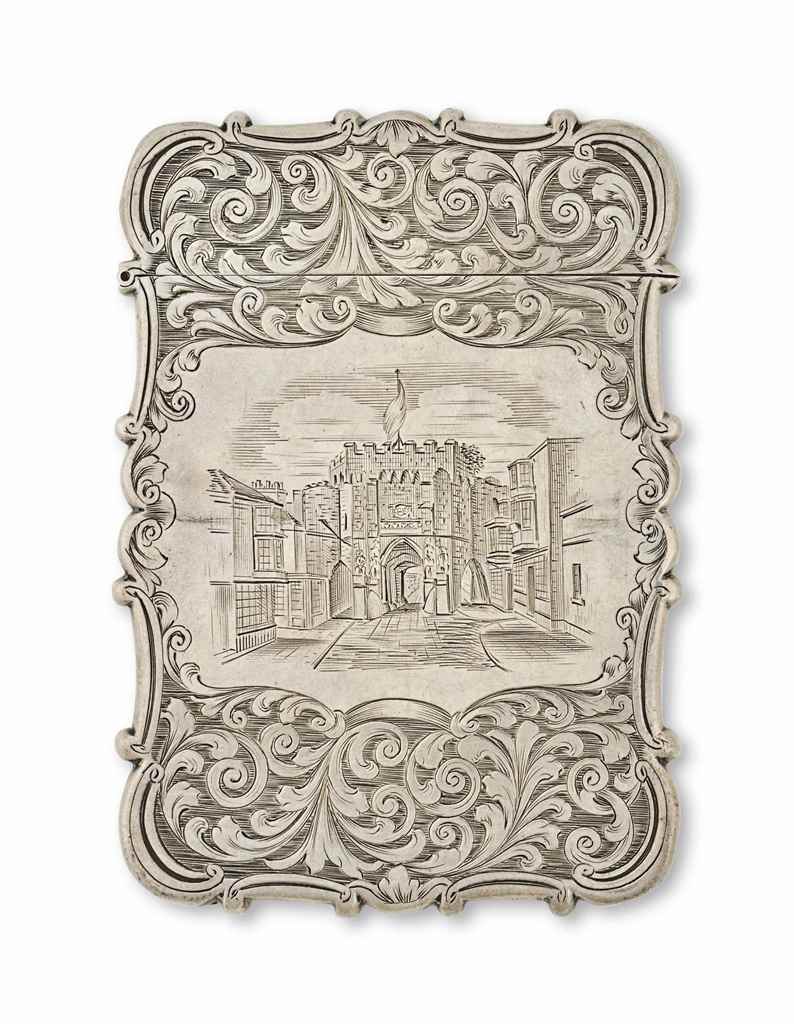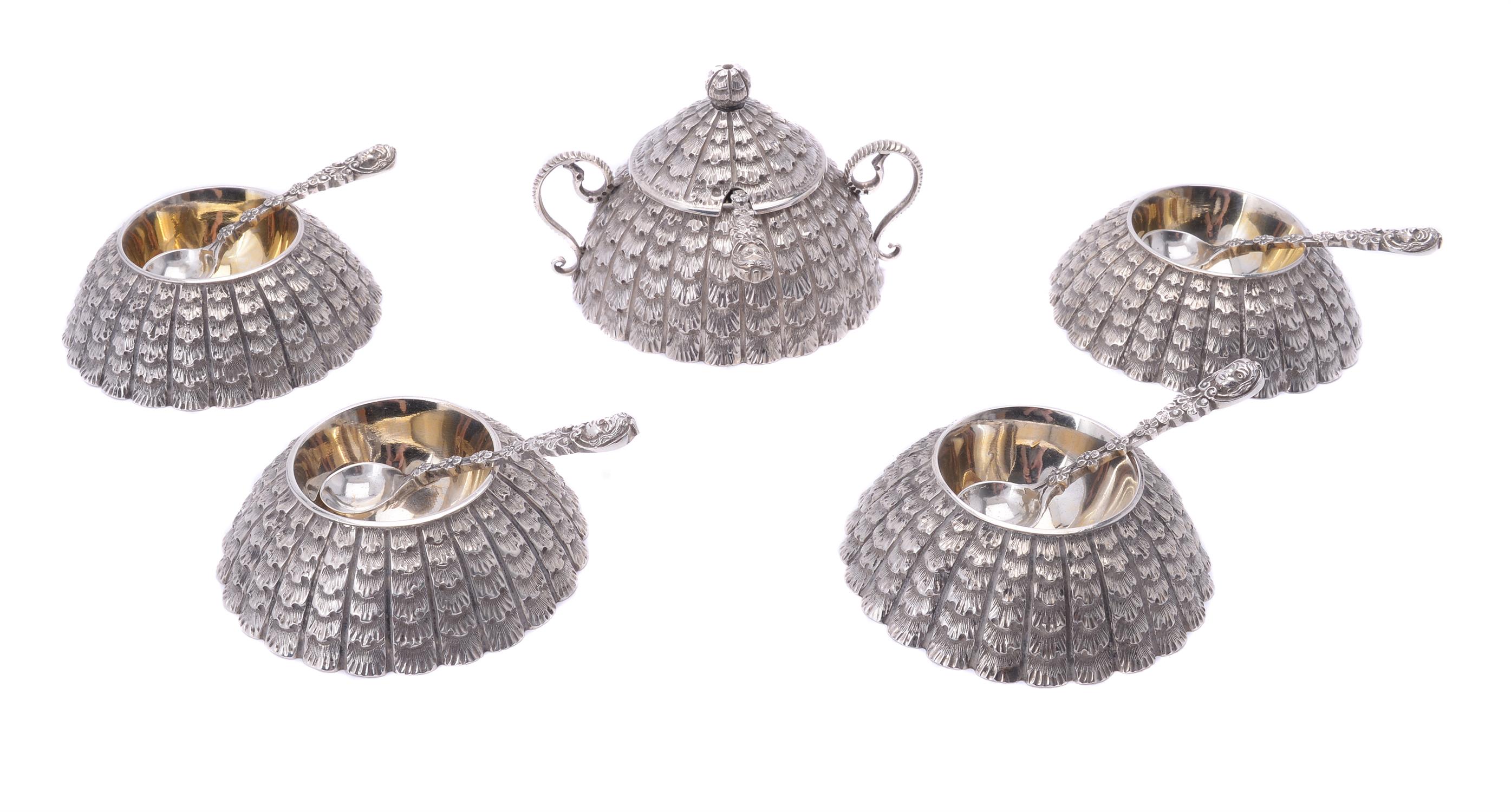A Rare Victorian Silver-Mounted "Harpy" Claret Jug, Alexander Crichton, London, 1882
the glass body frosted and engraved with overlapping feathers, folded-back wings, and crossed arms at the front, on three short glass feet, plain glass handle, the tail with chased silver mount, the neck with classical female face surrounded by drapery and topped with a diadem, the hinged cover chased as her waved hair, palmette thumbpiece, gilt interior, fully marked below face, part marked inside cover and on tail mount
Height 8 in.20.3 cmCondition reportTraces of black in some of the engraved glass lines. A slight fissure in silver drapery right of face but stable, not obvious. Otherwise good condition.
The lot is sold in the condition it is in at the time of sale. The online condition report is provided to assist you with assessing the condition of the lot and is for guidance purposes only. The images of the lot also form part of the online condition report for the lot provided by Sotheby's. Any reference to condition in the online condition report does not amount to a full description of condition. The online condition report may make reference to particular imperfections of the lot but you should note that the lot may have other faults not expressly referred to in the online condition report of the lot or shown in the online images of the lot. The online condition report may not refer to all faults, restoration, alteration or adaptation because Sotheby's is not a professional conservator or restorer but rather the online condition report is a statement of subjective, qualified opinion genuinely held by Sotheby's (for example, information regarding colour, clarity and weight of gemstones are statements of opinion only and not statements of fact by Sotheby's). Please also note that we do not guarantee, and are not responsible for, any certificate from a gemological laboratory that may accompany the lot. In addition, certain images of the lot provided online may not accurately reflect the actual condition of the lot (for example, the online images may represent colours and shades which are different to the lot's actual colour and shades). For these reasons, the online condition report is not an alternative to taking your own professional advice regarding the condition of the lot. Prospective buyers should also refer to the relevant section the Buying at Auction guide which includes important notices concerning the type of property in this sale. NOTWITHSTANDING THIS ONLINE CONDITION REPORT OR ANY DISCUSSIONS CONCERNING A LOT, ALL LOTS ARE OFFERED AND SOLD "AS IS" IN ACCORDANCE WITH THE CONDITIONS OF SALE/BUSINESS APPLICABLE TO THE RESPECTIVE SALE.Catalogue noteThis shape follows classical pottery models of a "siren" jug, and reflects the "Grecian" tastes of the mid 19th century. The form is known from Greek and Etruscan examples; one with incised crossed arms, probably the prototype for the Victorian versions, is in the collection of the British Museum and is dated to Crete, 600 B.C.E. An 1877 "harpy" milk jug by James Barclay Hennell for Edwin W. Streeter (retailer, New Bond Street) is illustrated in John Culme, Nineteenth Century Silver, p. 181. A fully silver jug by Aldwinkle & Slater, London, 1882, was sold Sotheby's, New York, October 17, 2008, lot 146, and an unusual example with a Doulton Lambeth stoneware body, the silver head marked by Alexander Crichton, was sold Lion and Unicorn Auctions, April 20, 2021, lot 322.
Alexander CrichtonThe Father of figural claret jugs is Alexander Crichton, who almost single-handedly launched the craze in the early 1880s. John Culme has found a first mention of Crichton in 1870, when he entered an embossed up into the Society of Arts Exhibition, an early testament to his skills. He entered marks by himself in 1872 and 1875, and an early production was retailed by Hamilton, Crichton & Co. of Edinburg, suggesting a possible family connection. A pair of silver-gilt shields of 1878 depicted “A Midsummer Night’s Dream”, after designs by Sir Noel Paton showing his engagement with the fantastic.In 1880 he went into partnership with Charles John Curry, who hailed from a family of silversmiths and spent seven years apprenticeship as a modeler and chaser with Edward Barnard & Sons. Describing themselves as designers, modelers, and silversmiths, they are recorded as “Crichton & Curry”, 45 Rathbone Place, off Oxford Street, on October 14. 1880. Less than a year later registered their first figural design, an owl-form jug, on August 16, 1881. This was followed in quick succession by the Walrus on September 22, the Duck and the Drake on October 1, and the Parrot on December 3, all of 1881.
Several of the figural claret jugs of the following year, 1882, bear Crichton’s maker’s mark but the retailers mark of Henry Lewis of 172 New Bond Street. The new registered designs of 1882 were done in Lewis’ name as well, the Dodo of February 1, the Carp of February 18, and the Otter of March 7th, but the known examples all have the maker’s mark of Alexander Crichton.
Crichton & Curry would register two more designs for figural jugs, the Penguin of April 26, 1882, and the Cockatoo of December 19; perhaps this change represents a falling out with Henry Lewis However, losing their primary wholesale purchaser would have been risky in the depressed economy of the early 1880s, and by 1882 other firms had jumped onto the bandwagon of figural jugs, causing competition in the novelty market. Crichton would create a bear-form honeypot to the designs of sculptor Sir Joseph Boehm in 1883, to be given as a gift to the Royal Academy, but the partnership was dissolved by October 1884, and Crichton declared bankruptcy in December 1886, with debts of £1,846. However short-lived his business, Alexander Crichton left a legacy of creativity and craftsmanship that has far outlived him.
A Rare Victorian Silver-Mounted "Harpy" Claret Jug, Alexander Crichton, London, 1882
the glass body frosted and engraved with overlapping feathers, folded-back wings, and crossed arms at the front, on three short glass feet, plain glass handle, the tail with chased silver mount, the neck with classical female face surrounded by drapery and topped with a diadem, the hinged cover chased as her waved hair, palmette thumbpiece, gilt interior, fully marked below face, part marked inside cover and on tail mount
Height 8 in.20.3 cmCondition reportTraces of black in some of the engraved glass lines. A slight fissure in silver drapery right of face but stable, not obvious. Otherwise good condition.
The lot is sold in the condition it is in at the time of sale. The online condition report is provided to assist you with assessing the condition of the lot and is for guidance purposes only. The images of the lot also form part of the online condition report for the lot provided by Sotheby's. Any reference to condition in the online condition report does not amount to a full description of condition. The online condition report may make reference to particular imperfections of the lot but you should note that the lot may have other faults not expressly referred to in the online condition report of the lot or shown in the online images of the lot. The online condition report may not refer to all faults, restoration, alteration or adaptation because Sotheby's is not a professional conservator or restorer but rather the online condition report is a statement of subjective, qualified opinion genuinely held by Sotheby's (for example, information regarding colour, clarity and weight of gemstones are statements of opinion only and not statements of fact by Sotheby's). Please also note that we do not guarantee, and are not responsible for, any certificate from a gemological laboratory that may accompany the lot. In addition, certain images of the lot provided online may not accurately reflect the actual condition of the lot (for example, the online images may represent colours and shades which are different to the lot's actual colour and shades). For these reasons, the online condition report is not an alternative to taking your own professional advice regarding the condition of the lot. Prospective buyers should also refer to the relevant section the Buying at Auction guide which includes important notices concerning the type of property in this sale. NOTWITHSTANDING THIS ONLINE CONDITION REPORT OR ANY DISCUSSIONS CONCERNING A LOT, ALL LOTS ARE OFFERED AND SOLD "AS IS" IN ACCORDANCE WITH THE CONDITIONS OF SALE/BUSINESS APPLICABLE TO THE RESPECTIVE SALE.Catalogue noteThis shape follows classical pottery models of a "siren" jug, and reflects the "Grecian" tastes of the mid 19th century. The form is known from Greek and Etruscan examples; one with incised crossed arms, probably the prototype for the Victorian versions, is in the collection of the British Museum and is dated to Crete, 600 B.C.E. An 1877 "harpy" milk jug by James Barclay Hennell for Edwin W. Streeter (retailer, New Bond Street) is illustrated in John Culme, Nineteenth Century Silver, p. 181. A fully silver jug by Aldwinkle & Slater, London, 1882, was sold Sotheby's, New York, October 17, 2008, lot 146, and an unusual example with a Doulton Lambeth stoneware body, the silver head marked by Alexander Crichton, was sold Lion and Unicorn Auctions, April 20, 2021, lot 322.
Alexander CrichtonThe Father of figural claret jugs is Alexander Crichton, who almost single-handedly launched the craze in the early 1880s. John Culme has found a first mention of Crichton in 1870, when he entered an embossed up into the Society of Arts Exhibition, an early testament to his skills. He entered marks by himself in 1872 and 1875, and an early production was retailed by Hamilton, Crichton & Co. of Edinburg, suggesting a possible family connection. A pair of silver-gilt shields of 1878 depicted “A Midsummer Night’s Dream”, after designs by Sir Noel Paton showing his engagement with the fantastic.In 1880 he went into partnership with Charles John Curry, who hailed from a family of silversmiths and spent seven years apprenticeship as a modeler and chaser with Edward Barnard & Sons. Describing themselves as designers, modelers, and silversmiths, they are recorded as “Crichton & Curry”, 45 Rathbone Place, off Oxford Street, on October 14. 1880. Less than a year later registered their first figural design, an owl-form jug, on August 16, 1881. This was followed in quick succession by the Walrus on September 22, the Duck and the Drake on October 1, and the Parrot on December 3, all of 1881.
Several of the figural claret jugs of the following year, 1882, bear Crichton’s maker’s mark but the retailers mark of Henry Lewis of 172 New Bond Street. The new registered designs of 1882 were done in Lewis’ name as well, the Dodo of February 1, the Carp of February 18, and the Otter of March 7th, but the known examples all have the maker’s mark of Alexander Crichton.
Crichton & Curry would register two more designs for figural jugs, the Penguin of April 26, 1882, and the Cockatoo of December 19; perhaps this change represents a falling out with Henry Lewis However, losing their primary wholesale purchaser would have been risky in the depressed economy of the early 1880s, and by 1882 other firms had jumped onto the bandwagon of figural jugs, causing competition in the novelty market. Crichton would create a bear-form honeypot to the designs of sculptor Sir Joseph Boehm in 1883, to be given as a gift to the Royal Academy, but the partnership was dissolved by October 1884, and Crichton declared bankruptcy in December 1886, with debts of £1,846. However short-lived his business, Alexander Crichton left a legacy of creativity and craftsmanship that has far outlived him.















Try LotSearch and its premium features for 7 days - without any costs!
Be notified automatically about new items in upcoming auctions.
Create an alert